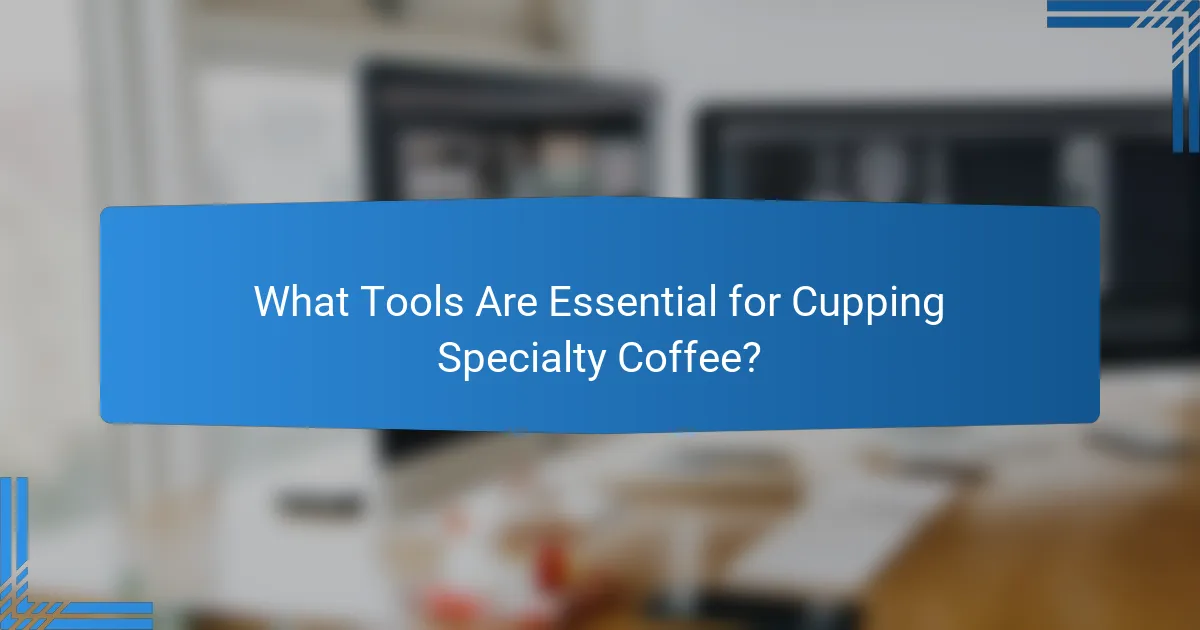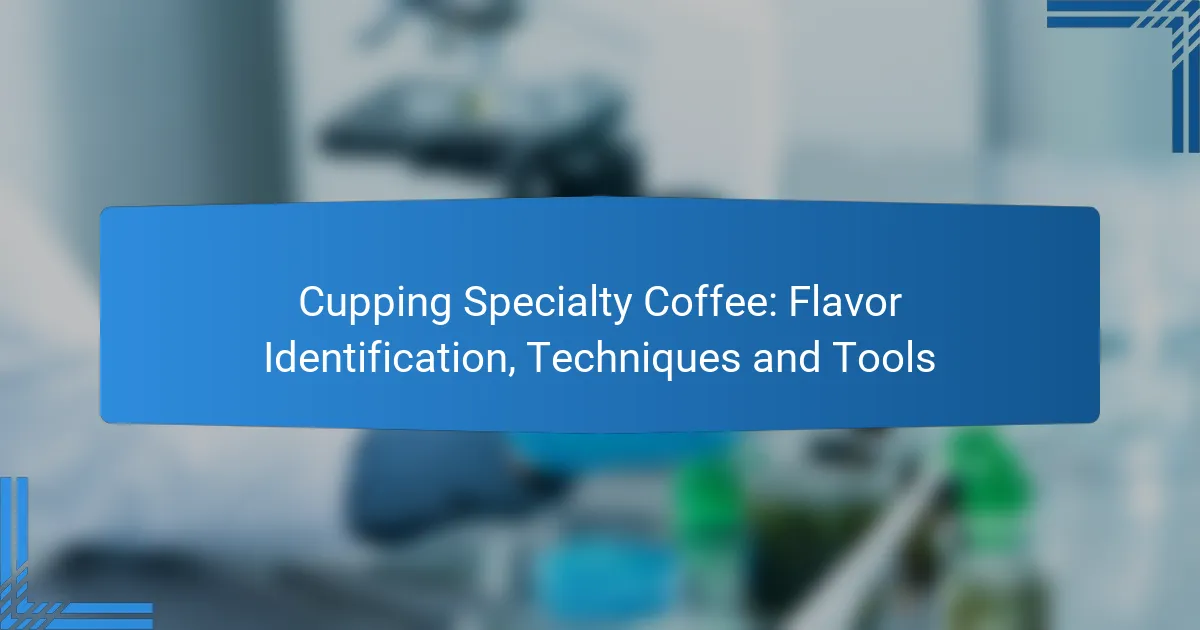Cupping specialty coffee is a vital practice for professionals seeking to identify and evaluate the unique flavors and aromas of different brews. By employing various techniques such as manual and comparative cupping, coffee experts can assess quality and characteristics effectively. Essential tools like cupping bowls, grinders, and thermometers are crucial for ensuring accurate flavor identification and consistency throughout the process.

What Are the Best Cupping Techniques for Specialty Coffee?
The best cupping techniques for specialty coffee include manual, automated, comparative, single-origin, and blending cupping. Each method offers unique advantages for flavor identification and evaluation, allowing coffee professionals to assess quality and characteristics effectively.
Manual cupping
Manual cupping is a hands-on approach where coffee is brewed in small batches, typically using a cupping bowl. The process involves evaluating aroma, flavor, acidity, body, and aftertaste by slurping the coffee to aerate it on the palate. This technique is favored for its simplicity and the direct sensory experience it provides.
When performing manual cupping, ensure consistent grind size and water temperature, ideally around 200°F (93°C). Use a standard ratio of about 1:15 coffee to water for optimal extraction.
Automated cupping
Automated cupping utilizes machines to brew and analyze coffee samples, offering precision and consistency. These systems can control variables like temperature and brew time, reducing human error and ensuring repeatability in results.
While automated cupping can enhance efficiency, it may lack the nuanced sensory experience of manual cupping. It’s best used in larger operations where consistency is crucial, such as in quality control labs.
Comparative cupping
Comparative cupping involves tasting multiple coffee samples side by side to evaluate differences in flavor and quality. This technique is useful for identifying subtle distinctions between beans from various origins or processing methods.
To conduct comparative cupping, select samples with similar roast profiles and prepare them under identical conditions. This method helps in making informed decisions about sourcing and blending.
Single-origin cupping
Single-origin cupping focuses on evaluating coffee from a specific region or farm, highlighting unique flavor profiles associated with that locale. This technique is essential for understanding the characteristics imparted by terroir, processing methods, and varietals.
When cupping single-origin coffees, pay attention to the distinct flavors and aromas that emerge, which can range from fruity to earthy. This method is particularly valuable for roasters aiming to showcase specific origins in their offerings.
Blending cupping
Blending cupping is used to evaluate and create coffee blends by combining different beans to achieve a desired flavor profile. This technique allows roasters to balance acidity, sweetness, and body, resulting in a harmonious cup.
During blending cupping, experiment with various ratios of beans and take notes on how each combination affects the overall flavor. This iterative process can lead to unique blends that cater to specific consumer preferences.

How to Identify Flavor Notes in Cupping?
Identifying flavor notes in cupping involves recognizing and articulating the distinct tastes and aromas present in coffee. This process is essential for evaluating coffee quality and understanding its unique characteristics.
Using flavor wheels
Flavor wheels are visual tools that categorize various coffee flavors and aromas, helping tasters pinpoint specific notes. They typically feature a range of flavors, from fruity and floral to nutty and earthy, allowing for a structured approach to tasting.
When using a flavor wheel, start by smelling and tasting the coffee, then refer to the wheel to find descriptors that match your experience. This can enhance your vocabulary and improve your ability to communicate flavor profiles effectively.
Descriptive tasting
Descriptive tasting involves articulating the sensory experience of coffee through detailed observations. This method encourages tasters to focus on aspects such as acidity, body, sweetness, and aftertaste.
To practice descriptive tasting, take notes on each of these elements while sampling different coffees. Use specific terms to describe what you perceive, which can help refine your palate and improve your overall cupping skills.
Scoring sheets
Scoring sheets provide a structured format for evaluating coffee based on various criteria, including aroma, flavor, acidity, body, and overall impression. These sheets often use a numerical scale, allowing for consistent comparisons across different coffees.
When using scoring sheets, be consistent in your evaluations and consider using a scale from 1 to 10 for each category. This method not only helps in tracking preferences but also aids in identifying standout coffees during cupping sessions.

What Tools Are Essential for Cupping Specialty Coffee?
To effectively cup specialty coffee, several essential tools are required to ensure accurate flavor identification and consistency. These tools include cupping bowls, grinders, scales, thermometers, and timers, each playing a crucial role in the cupping process.
Cupping bowls
Cupping bowls are specifically designed vessels used to hold coffee during the cupping process. Typically, they have a capacity of around 200-250 ml and are made from materials that do not interfere with the coffee’s aroma or flavor, such as glass or ceramic.
When selecting cupping bowls, ensure they are uniform in size and shape to maintain consistency across samples. This uniformity allows for a fair comparison of flavors and aromas during the tasting process.
Grinders
A quality grinder is essential for achieving a consistent grind size, which directly affects the extraction of flavors during cupping. Burr grinders are preferred over blade grinders, as they provide a more uniform grind, typically ranging from medium to coarse for cupping.
When grinding coffee for cupping, aim for a grind size similar to that of sea salt. This consistency helps in extracting the coffee’s flavors evenly, allowing for a more accurate assessment of the coffee’s profile.
Scales
Using a scale is crucial for measuring both coffee and water accurately, ensuring a consistent brew ratio. A common starting point for cupping is a ratio of 1:15, meaning one part coffee to fifteen parts water.
Invest in a digital scale that can measure in grams with precision. This accuracy is vital for replicating the cupping process and achieving the desired flavor profile consistently.
Thermometers
A thermometer is important for monitoring water temperature during the brewing process, as temperature significantly influences flavor extraction. The ideal temperature for cupping is typically between 90-95°C (194-203°F).
Using a digital thermometer can help you achieve precise temperature control, which is essential for consistent results. Avoid using water that is too hot, as it can lead to over-extraction and bitterness in the coffee.
Timers
Timers are essential for tracking steeping times during the cupping process. Standard steeping times range from 4 to 5 minutes, depending on the coffee and personal preference.
Using a timer ensures that each sample is brewed for the same duration, which is critical for accurate flavor assessment. Consider using a stopwatch or a timer app on your phone to keep track of the brewing times effectively.

What Are the Benefits of Cupping Specialty Coffee?
Cupping specialty coffee offers several benefits, including the ability to identify unique flavor profiles and assess the quality of beans. This process is essential for coffee professionals and enthusiasts alike, as it enhances the overall appreciation and understanding of different coffee varieties.
Flavor profile development
Cupping allows coffee tasters to explore and develop a comprehensive flavor profile for each coffee variety. By evaluating aroma, acidity, sweetness, and body, cuppers can identify distinct characteristics that contribute to the coffee’s overall taste. This process often involves comparing multiple samples side by side to highlight differences and similarities.
To effectively develop flavor profiles, tasters should focus on specific attributes such as fruitiness, nuttiness, or floral notes. Keeping a flavor wheel handy can help in identifying these nuances and improving the tasting experience.
Quality assessment
Cupping is a critical tool for assessing the quality of specialty coffee. It helps identify defects and inconsistencies that may affect the final product. By adhering to established cupping protocols, professionals can ensure a standardized evaluation process that reflects the coffee’s true potential.
Common quality indicators include the presence of off-flavors, uniformity, and overall balance. Regular cupping sessions can help roasters and producers maintain high standards and make informed decisions about sourcing and roasting practices.
Training for baristas
Cupping serves as an invaluable training tool for baristas, enhancing their sensory skills and coffee knowledge. Through practice, baristas can learn to identify various flavor notes and understand the impact of different brewing methods on taste. This knowledge ultimately improves customer service and product recommendations.
Baristas should engage in regular cupping sessions to refine their skills. Participating in workshops or guided tastings can further enhance their understanding of coffee origins and processing methods, leading to a more informed and passionate approach to serving coffee.

What Are the Common Mistakes in Coffee Cupping?
Common mistakes in coffee cupping can significantly impact flavor identification and overall experience. Key errors include using the wrong grind size, incorrect water temperature, and inconsistent brewing times, all of which can lead to misleading results.
Improper grind size
The grind size of coffee beans is crucial for proper extraction during cupping. If the grind is too coarse, flavors may be under-extracted, resulting in a weak cup; too fine, and the coffee can become over-extracted, leading to bitterness. A medium grind is generally recommended for cupping, similar to that used for a standard drip brew.
To avoid this mistake, consider using a burr grinder for consistent results. Aim for a grind that resembles granulated sugar, which typically allows for optimal flavor extraction during the cupping process.
Incorrect water temperature
Water temperature plays a vital role in coffee extraction. Using water that is too hot can scorch the coffee, while water that is too cool may not extract the full range of flavors. The ideal temperature for cupping is around 90-95°C (194-203°F).
To ensure accuracy, use a thermometer to measure the water temperature before pouring it over the coffee grounds. This practice helps maintain consistency and enhances the flavor profile of the coffee being evaluated.
Inconsistent brewing time
Brewing time affects how flavors develop in coffee. If the brewing time varies, it can lead to inconsistent results, making it difficult to accurately assess the coffee’s characteristics. A standard cupping time is typically around 4 minutes.
To maintain consistency, use a timer and adhere to the same brewing duration for each sample. This approach allows for a fair comparison of different coffees and helps identify subtle flavor differences effectively.
